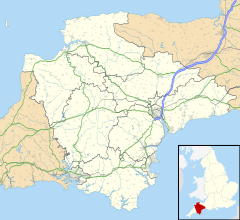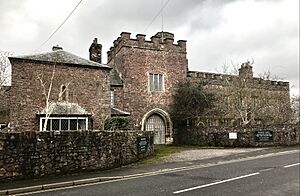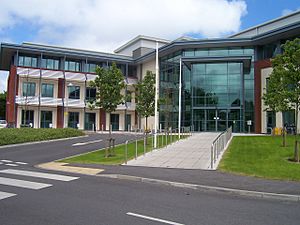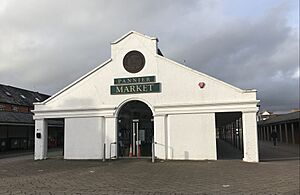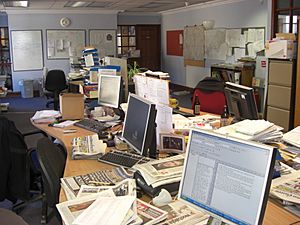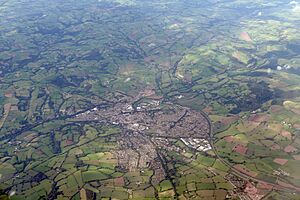Tiverton, Devon facts for kids
Quick facts for kids Tiverton |
|
|---|---|
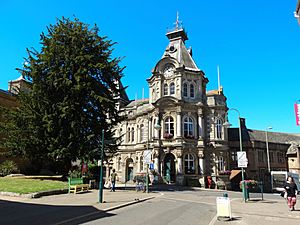 Tiverton Town Hall |
|
| Population | 22,291 (2021 Census) |
| OS grid reference | SS955125 |
| Civil parish |
|
| District | |
| Shire county | |
| Region | |
| Country | England |
| Sovereign state | United Kingdom |
| Post town | TIVERTON |
| Postcode district | EX16 |
| Dialling code | 01884 |
| Police | Devon and Cornwall |
| Fire | Devon and Somerset |
| Ambulance | South Western |
| EU Parliament | South West England |
| UK Parliament |
|
Tiverton is a town in Devon, England. It's a busy center for business and government in the Mid Devon area. In 2021, about 22,291 people lived here. The town is known for its interesting history and its location where two rivers meet.
Contents
Discovering Tiverton's Past
How Tiverton Got Its Name
Tiverton's name likely comes from "Twy-ford-ton," meaning "the town on two fords." A ford is a shallow place in a river where you can cross. The town is built where the River Exe and River Lowman join together.
Ancient Times and Early Settlements
People have lived in the Tiverton area since the Stone Age. Many old flint tools have been found here. There's an Iron Age hill fort called Cranmore Castle on Exeter Hill. Romans also had a fort nearby, found on the hillside below Knightshayes Court.
In 1066, a powerful woman named Countess Gytha of Wessex controlled Tiverton. Later, William the Conqueror took charge of the town. In 1106, King Henry I built Tiverton Castle as a strong Norman castle. It started as a Motte and Bailey castle.

The Medieval Waterway: Town Leat
Tiverton has a special medieval waterway called a "leat." It was built by Isabella de Fortibus, a Countess of Devon. She also controlled the Port of Topsham, Devon, which was important for Tiverton's wool trade.
Every seven years, there's a special ceremony called the "Perambulation of the Town Leat." People walk along the leat's path to make sure it stays clear and flowing. You can still see parts of the leat in Castle Street and at Coggan's Well.
Wool Trade and Wealthy Merchants
Tiverton grew rich and important because of the wool trade. In the 16th and 17th centuries, many wealthy wool merchants lived here.
- John Greenway (1460–1529) added a chapel to St Peter's Church in 1517. He also built small chapels and almshouses (homes for the poor) in Gold Street, which are still used today.
- Peter Blundell (died 1601) was another rich merchant. He left money and land to start Blundell's School in 1604. This school was built to educate local children. It's now an independent school on the edge of town.
- John Waldron (died 1579) founded Waldron's Almshouses on Wellbrook Street. His tomb is still in St Peter's Church.
Fires and the English Civil War
Around the 1600s, Tiverton suffered from two big fires.
- In 1596, a fire destroyed most of the town.
- In 1612, another fire, known as the "dog-fight fire," burned 260 homes.
During the English Civil War in 1645, Tiverton Castle was held by the Royalists (supporters of the King). Thomas Fairfax's Parliamentarian forces attacked it. The siege ended quickly when a lucky shot broke a drawbridge chain, and the Parliamentarian soldiers got inside.
Changes in the 18th and 19th Centuries
The wool trade brought good times in the early 1700s. But then, Tiverton faced a decline as the Industrial Revolution began. Another big fire in 1731 destroyed many houses, leading to wider streets being built.
In 1815, an inventor named John Heathcoat bought a woollen mill in Tiverton. He moved his lace-making business here, which helped the town's economy grow again.
Transport also improved:
- The Grand Western Canal opened in 1814, connecting Tiverton to Lowdwells.
- A branch of the Great Western Railway arrived in 1848.
- Tiverton Town Hall was finished in 1864.
Politics and Reform
Tiverton used to have two Members of Parliament (MPs), even though it was a small town. This was part of the "rotten boroughs" system, which many people wanted to change.
Lord Palmerston was an MP for Tiverton for many years. In 1847, a group called the Chartists wanted to change the voting system. Their leader, George Julian Harney, stood against Palmerston. Harney won the "popular vote" (a show of hands) but lost when a formal ballot was held, as only wealthy people could vote then. After the Reform Act of 1867, Tiverton had only one MP.
Tiverton Today: 20th and 21st Centuries
Tiverton started to grow again in the late 1980s with the building of the A361 (North Devon Link Road). New industrial areas and roads were built, making it easier to get to the town.
Many people now live in Tiverton and travel to work in Exeter or Taunton. This has led to new housing projects and more services and shops in town.
- A new leisure center with a swimming pool and gym replaced the old one.
- The Mid Devon District Council moved to new offices in 2003.
- A new Tiverton and District Hospital opened in 2004.
- The Pannier Market was redeveloped in 2006, making it bigger and allowing more frequent markets.
The Tivoli cinema, which had closed, reopened in 2008 after a public campaign. Tiverton also hosts the annual Mid Devon Show.
Education in Tiverton
Tiverton has many schools for different ages:
- Blundell's School: an independent school.
- Bolham Primary School
- The Castle Primary School: a new building opened in 2017.
- East Anstey County Primary School
- Halberton Primary School
- Heathcoat Primary School
- Petroc College: a college for further education, sharing a campus with Tiverton High School.
- Rackenford Primary School
- St John's Roman Catholic Primary School
- Tidcombe Primary School: now an academy.
- Tiverton High School: the local secondary school, specializing in visual arts.
- Two Moors Primary School
- Wilcombe Primary School: now part of an academy.
- Witheridge V. P. (C) School
Getting Around Tiverton
Road Travel
Tiverton is close to the M5 motorway. The A361 North Devon Link Road, built in the 1980s, helped the town's growth.
Coach and Bus Services
National Express offers coach services from Tiverton bus station to London and North Devon.
Most local bus services are run by Stagecoach South West. They offer frequent services to Exeter and South Molton. Other companies like First Buses of Somerset and Dartline Coaches also run services to Taunton and Dulverton.
Train Connections
Tiverton used to have several train lines, but they are now closed.
- The Bristol and Exeter Railway opened a station in 1844, later called Tiverton Junction railway station.
- A branch line went closer to the town, to Tiverton railway station.
- Other lines connected to the Exe Valley and north towards Dulverton.
In 1986, Tiverton Parkway railway station opened on the main line, about six miles east of town. It's near Junction 27 of the M5 motorway, making it easy for people to access.
Canal Transport
The Grand Western Canal from Taunton to Tiverton opened in 1838. Today, it's a country park.
Sports and Activities
Tiverton has several sports clubs:
- Tiverton Town: the main football club.
- Amateur football clubs like Elmore and Amory Green Rovers.
- A rugby club.
- Several cricket clubs.
- Tiverton White Eagles: a women's hockey club.
Local News and Media
The Tiverton Gazette is a weekly newspaper for the area. It started in 1858. Over the years, it split into different editions and then recombined.
Local TV news comes from BBC South West and ITV West Country. Tiverton also has local radio stations like BBC Radio Devon, Heart West, Greatest Hits Radio South West, Radio Exe, and TCR Radio.
Tiverton's Location and Climate
Tiverton is in north-east Devon, about 13 miles (21 km) north of Exeter. The villages of Ashley and Bolham are now part of Tiverton. The River Exe flows through the town.
Tiverton has an oceanic climate, which means it has mild temperatures and rain throughout the year.
| Climate data for Tiverton | |||||||||||||
|---|---|---|---|---|---|---|---|---|---|---|---|---|---|
| Month | Jan | Feb | Mar | Apr | May | Jun | Jul | Aug | Sep | Oct | Nov | Dec | Year |
| Mean daily maximum °C (°F) | 8 (46) |
8 (46) |
10 (50) |
12 (54) |
16 (61) |
19 (66) |
21 (70) |
21 (70) |
18 (64) |
14 (57) |
11 (52) |
9 (48) |
14 (57) |
| Mean daily minimum °C (°F) | 3 (37) |
3 (37) |
3 (37) |
4 (39) |
7 (45) |
11 (52) |
12 (54) |
12 (54) |
10 (50) |
8 (46) |
5 (41) |
1 (34) |
7 (45) |
| Source: Weather Channel | |||||||||||||
Sister Cities
Tiverton is twinned with Hofheim am Taunus in Germany.
Famous People from Tiverton
Many notable people have connections to Tiverton:
- Isabella de Redvers, Countess of Devon (1237–1293): The countess who helped build the Town Leat.
- John Greenway (c. 1460–1529): A rich wool merchant and church supporter.
- Catherine of York (1479–1572): A daughter of King Edward IV, who died at Tiverton Castle.
- John Waldron (died 1579): A wealthy merchant who founded "Waldron's Almshouses."
- Peter Blundell (1520–1601): The merchant who founded Blundell's School.
- Peter Sainthill (1593–1648): A Member of Parliament for Tiverton.
- John Heathcoat (1783–1861): An industrialist who invented the bobbinet lace machine and was an MP for Tiverton.
- Lord Palmerston (1784–1865): A long-serving MP for Tiverton and twice Prime Minister.
- Richard Cosway (1742–1821): A famous miniature portrait painter.
- Hannah Cowley (1743–1809): A playwright and poet.
- William Oxenham (1823–1875): A recipient of the Victoria Cross.
- J. D. Salinger (1919–2010): The author of The Catcher in the Rye, who spent time in Tiverton.
- Bobby G (born 1953): A singer from the pop group Bucks Fizz.
- Mark Labbett (born 1965): A television personality.
See also
 In Spanish: Tiverton para niños
In Spanish: Tiverton para niños


